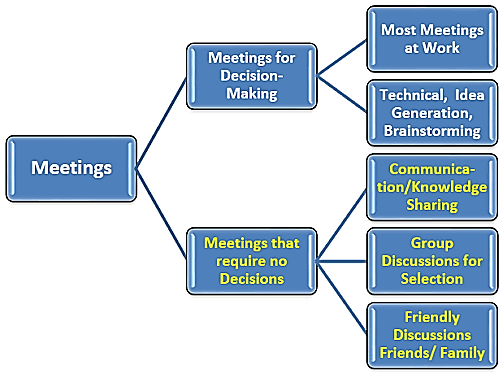Rules of Effective Meetings
and Brain Storming Sessions
by

Rules of Effective Meetings and Brain Storming Sessions
copyright © 2001-21 Prem Kamble
Types of Meetings
 Both in professional and personal lives, group
discussions, meetings and friendly arguments are a part of our life.
It can help us to effectively participate in any of such discussions
if we are aware of the rules and etiquettes of such meetings and of
our own roles and responsibilities as participants.
Both in professional and personal lives, group
discussions, meetings and friendly arguments are a part of our life.
It can help us to effectively participate in any of such discussions
if we are aware of the rules and etiquettes of such meetings and of
our own roles and responsibilities as participants.
Our roles and responsibilities vary based on what type of discussion it is and
what we are supposed to contribute. Broadly, the discussions and meetings
can be of two types:
1. Meetings for Decision Making:
These are
meetings which are
required for decision making, and where some action is desired
based on the outcome of the discussion. At work, most
of our meetings are of this category. The discussions are usually
followed by a decision and a planned action.
2. Meetings that Require no Decision or Action:
These meetings do not need any
action or decision making. Communication meetings or knowledge
sharing meetings at workplace fall in this category as they are
not decision oriented. The other examples of such discussions
outside the work place are the group discussions at competitive
examinations (like the ones at MBA entrance examinations, and
the academic discussions for fun held
informally and leisurely with family and friends. (Update:) Today's
discussions in
social media like facebook are a great example of such discussions.
To summarise, discussions can be of following types:

This article looks at some of the ground rules of the all the above discussions.
Rules of discussion are, of course, extremely important at work. The article also
discusses how we can be effective in competitive group discussions and impress
the selectors. Even friendly discussions at times turn into heated
discussions resulting into ill feelings unless we understand the ground rules.
We shall see how we can actually enjoy academic discussions without creating
ill feelings due to differences of opinions.
Comments Index
Top
Discussion for Decision Making and Action

Characteristics of such Discussions
Business meetings at workplace typically have the following characteristics:
Comments Index
Top
Democratic or Autocratic

Decision making through meetings, discussions and consultations seems to be a very democratic way of decision making. At the same time there are some who believe that decisions cannot be made by democratic means - they need to be forced upon. Democratic approach at workplace does not mean that everyone decides. Decision is still made by one person, but after consulting his or her subordinates and involving them by hearing their views on the subject.
Most often, such decision-maker is a senior person in the organisation. He encourages discussions as it also gives him food for thought. It gives him different directions and alternatives to think into. Finally having heard all, he decides. He has that prerogative as he has to consider other environmental factors that influence the decisions which only he knows and which other participants may not be aware of. Being at senior position, he may have the best overview of the conditions in his company.
Thus, the responsibility of decision making is still with one person. Others help the decision maker by putting forth views, opinions and facts. Based on the views and facts presented, the leader can make a decision.
Therefore the process is normally a mix of democratic process and autocratic process. If the group comes to some conclusion unanimously, it could be a group decision, else the leader decides and that decision is binding on all.
"If they wanted to make these decisions on their own, why did they at all call us for a meeting to consult us?" I have often heard such comments after meetings in which decisions were made. It is a misconception that corporate group meetings are for joint decisions. Most often, decision is still made by one person.
People have the freedom to air their views, protest fervently if
necessary, but finally the decision is by one person. The participants generally feel good for having aired their views.
Comments Index
Top
Benefits of Meetings

Some people also make such comments after coming out of meetings,
"Oh, it was a waste of everybody's time. Finally he took
decision on his own". But they forget that such discussions have other
benefits in terms of motivating people:
Comments Index
Top
Responsibilities of the Co-ordinator

The person who plays the role of a coordinator
or leader for the meeting has the following responsibilities. He or she needs to:
If the co-ordinator is a senior person, he should see that his subordinates
feel free to express themselves and to challenge his own views.
Participants should have the freedom to air their views, protest strongly if
necessary. The meeting co-ordinator should make it clear to the
participants that they are free to air their views, but finally in the
interest of the whole proceedings, the decision has to be made by the
coordinator in case there is no consensus.
When I have conducted meetings, I have encouraged people to freely argue
against me. I encourage participants to put arguments and
counter-arguments, even against my point of view. But it is made very
clear right in the beginning that finally, having heard all arguments and views, the prerogative
to take decision is mine.
Comments Index
Top
Responsibilities of Participants: Recommended Code of Conduct

Whereas the Meeting coordinator has a role cut out for him and has clear cut responsibilities, the participants too should be aware that they have a role to play and also have responsibilities as participants. Some of them are discussed here.
Be Open to Listen
Comments Index
Top
Know the Meeting Etiquettes
Comments Index
Top
Keep Your Ego in Check

It is important that participants are open minded enough to
appreciate that there is nothing personal in arguments. Everyone must
realise that the arguments put forth are not for own benefits (though it
may often happen, as people will be people) but to achieve the company's
or group's objective. There has to be a professional
environment. Like true professionals, participants should understand that
they do not take remarks personally. You as a participant need to appreciate that people
will have different views and if they are expressing their view they are
not attacking you but only helping the process of decision-making by
discussing threadbare all aspects of a problem.
What would you do if you have a rock or a strange object from Mars in your
hand? You would look at it from all directions, turn it around and examine
from all angles. Look at the problem at hand as some object you are
examining and examine it from all angles and all sides with unprejudiced
mind as you would look at the rock. The personal feelings and ego create
the problem
Sometimes there may be senior colleagues and their direct reportees both
participating in
the same discussion. There is a tendency on the part of juniors not to
speak at all or not to negate their superior. The boss should encourage
their subordinates to speak. It is the responsibility of the boss to keep
his or her ego in check and show
openness to listen so that the subordinates feel free to talk.
People should have the freedom to air their views, protest if
necessary, but appreciate that finally the decision may or may not be in
line with their views. The participants
should feel good of having aired their views.
All participants should be open minded enough to accept that after all
hierarchies are there so that businesses can run. If there is no clear
collective decision, the president has the right to decide.
Participants should not feel offended if his/her idea is not accepted. It is not
important whether your idea is accepted or rejected. What is important is
that the group arrives jointly at some conclusion. If the group comes to
some conclusion unanimously, it is good, else the leader has to decide.
Participants must avoid saying "I was always saying this..., had you all listened
to me..." They should understand that once the decision is arrived
at, it is a collective decision, their own decision. All should accept
the decision and the outcome of the decision sportingly, keeping in mind
that this is the only way to arrive at a decision, else there would be no
decision. In the process, there may be a few wrong decisions, but that is
better than no decisions.
This may sound idealistic, but unless each participant appreciates this
reality, he or she would be only disappointed and frustrated in meetings.
Comments
Index
Top
Technical Meetings & Brainstorming Sessions

Meetings for decision-making could be different based on whether the issue
is technical or managerial. Managerial issues tend to be highly subjective
and hence chances of consensus are lower because of diversity of opinions.
Then the decision maker has to use his prerogative. In meetings
where technical issues are discussed, you need to adopt a slightly
different approach and strategy. In technical issues, opinions matter
less. Most of the time, there can be more objective discussions.
For brainstorming sessions, I have found that there are two very important
phases, and each phase has its own unique requirements. The two
phases are:
1. Identifying alternatives
2. Examining the pros and cons for each alternative
Pitfall 1
It is a good idea to assign a fixed time to phase 1 and only then go
into phase 2. There is a very high tendency to go into examining pros and cons
(phase 2) the moment one alternative or idea is suggested. This needs to be
consciously avoided. The group leader has to consciously bring back the group into identifying new alternatives when the group tends to naturally hurry into arguments for and against the suggested alternative. Avoiding the tendency to jump into
phase 2 prematurely before having devoted ample and sufficient time to identify all possible alternatives (phase 1) is, according to me, the most dangerous pitfall.
Avoiding this pitfall is the most critical to the success of such meetings.
The group should not go into discussions of ideas or
alternatives prematurely because that is where people have too many arguments/ ideas
and you tend to have hot discussions. In the hot discussions, it may
happen that you may spend the whole time debating the first not-so-good idea
that you hit upon, and may not even identify another alternative which may
turn out to be the best. Quite often, before going into discussions of
alternatives, I give extra 5 minutes when there is silence and people can
really think of new alternatives. If you rush into discussing alternatives,
some good alternatives may not even be identified, leave alone
discussed. Reserve some fixed time to brainstorm to identify and list alternatives.
Pitfall 2
'Out-of-the-blue' ideas are required so you
need to really concentrate and think exclusively on alternatives for
some time. List all the alternatives, however ridiculous it may sound initially. Rejecting some idea spontaneously because it sounds impossible, improbable or impracticable at first go is the second most dangerous pitfall. The group leader here also has to play a critical role in ensuring that ideas are not rejected however unsound, laughable or petty they may apparently be.
Index Top
Discussions Requiring no Decision or Action
Apart from the discussions at office, which are mainly for arriving at decisions
and thereafter getting into action, there can be other types of
discussions.
I can think of three major types:
1. Communication meetings and Knowledge Sharing meetings
2. Group discussions which are a part of interviews/selection process, and
3. Friendly group discussion with family and friends.
It may not be obvious, but these discussions too have certain rules
which can make you an effective participant.
Communication Meetings and Knowledge Sharing Meetings
Such meetings are common at work and outside work environment. Discussions can be one-to-many or many-to-may depending on who has or have the information and knowledge to share. Not many rules apply for such meetings, except that participants must actively participate and share.

Group Discussion in Interviews/Selection of Management Aspirants
Several selection processes have group discussions to assess the
candidates. For instance, most of the management
institutes have group discussions as a part of their selection process.
I have seen that most of the students go for such discussions with a
misconception that dominating a group discussion will help impress the
selectors. Here are some tips for such aspirants based on my real
experience in the group discussion
for selection to the management institute, IIM Calcutta, for which I did get selected.
The topic was "Can Women make Good Managers?"
As soon as the discussion started, two of the participants took off.
They would not let other candidates speak, obviously trying to hog
the limelight. At the same time they seemed to be talking mainly of
the physical strength of males over females implying
that women are too weak to be good managers.
I somehow managed to speak up and introduced a different line of thinking.
This is what I said.
"Friends, I think the discussion so far mainly focussed on the physical
strength or weakness. In my opinion, good management requires more of
mental or emotional strength and not physical strength. In my view, women are
emotionally stronger than men. I admit that I may be biased as my opinion
is based on limited people that I saw around me amongst family and friends.
I invite the views of other participants as to what they have
experienced in this regard."
In fact there was a young lady who was trying hard to speak, but unable
to do so. I invited her to express her views on the topic.
My intervention here helped me hit several birds in one stone:
- It gave a chance for other candidates to come out with more divergent views or even opposing views.
- It helped change the discussion from a monologue or dialogue to a more participative discussion.
- It helped emphasise that it was important for such discussions to have more participants express their views. In real life in businesses, when more diverse views and ideas are presented, there are more chances of a good decision.
- By making it clear that what I said was my view and that others may have a different view, I showed my openness to listen to the other side of the argument. I was not insisting that only my views were right and others' views were wrong.
The biggest misconception of most participants in such discussions is that it is important to have the "right" views or "firm" views on the given topic. In fact there are no right and wrong views. There are only views. What is more important is to present your thoughts as just your point of view, be open to listen to other points of view and encourage others to participate so that you can hear diverse views. By inviting more views and opinions you will be seen as helping the process of arriving at a consensus or collective decision.
Index Top
Friendly Discussion with Family & Friends
The friendly discussions within a group
of friends or family members should be looked at more as an intellectual game rather than a debate. They are generally discussions on topics of
common interest, on individual preferences, etc. Today, in the world of social
media, these discussions have become very common on sites like Facebook, and on
reader comments at the end of news articles on the web.
Quite often, if the participants do not have the right attitude, they
can end up in heated discussions with opposing parties abusing and
offending the other. They can end up with the participants feeling very
hurt and wretched and can even end up in real violence.
It will help if you remember the following rules of such friendly discussions:
Such discussions must be played as a game and nothing more than that.
The moment some participants feel that their egos were hurt during such
discussions, there is bound to be trouble.
copyright © 2001-21 Prem Kamble
Related Readings:
Seminar on Conducting Effective Meetings and Group Discussions
More Articles for Managers
All Articles by Prem Kamble
Also See:
More Seminars for CIOs